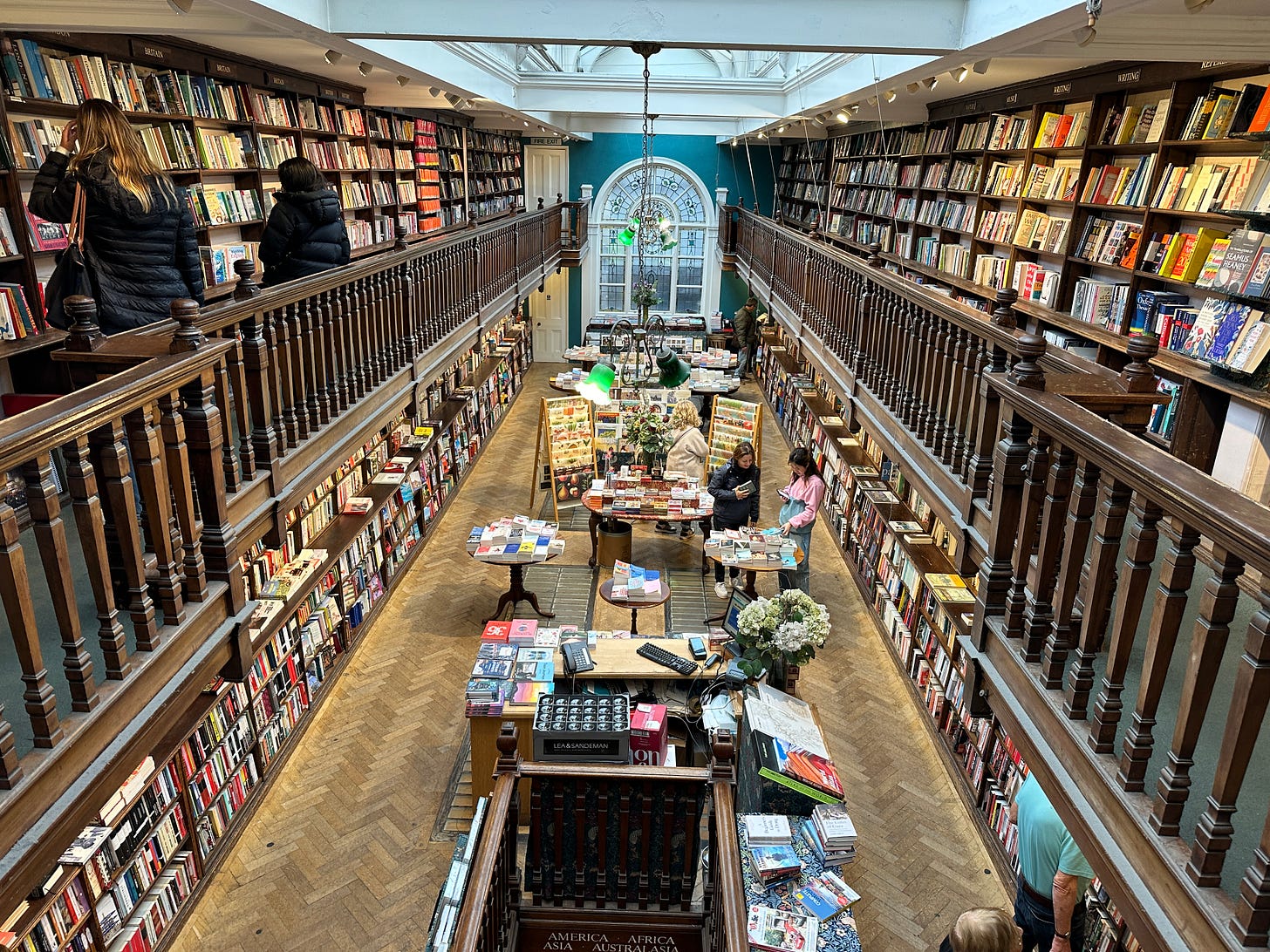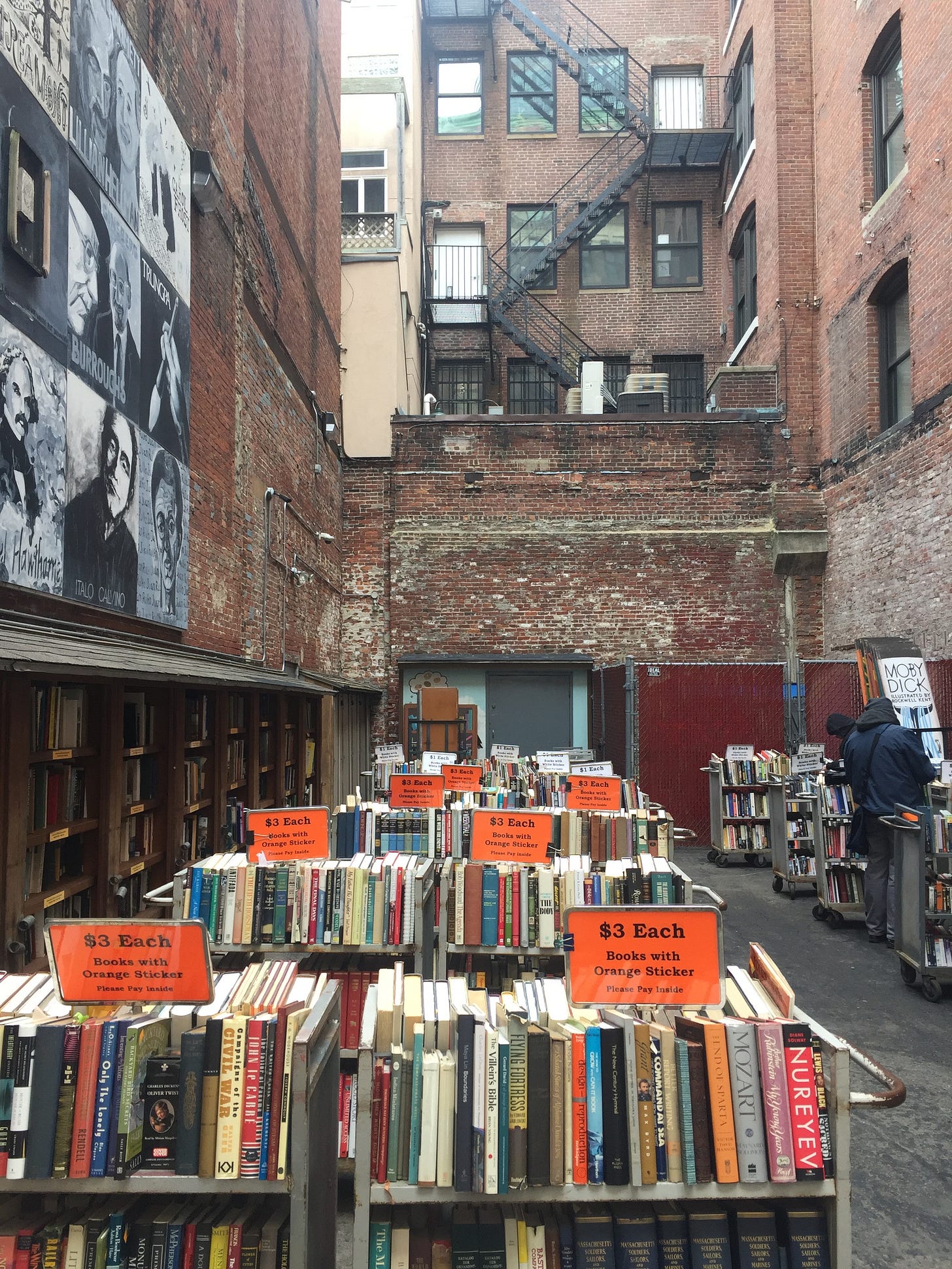
The Trilliumaires poster went kind of wild and I ordered another print run! // Lots of other art, prints, cards, etc. // A reminder that the best way to support this newsletter is to become a paid subscriber. Thank you to all of you who help bring this to life.
In my mid 20s, I worked in a bookstore for a year.
Imagine a small old house, painted yellow with blue trim. Remove all the furniture, fill every single wall with bookshelves and then stock them with new and used books. This was that store.
The bookshelves often sagged under the weight of all the books. Not only were books on the shelves. They were stacked on the floor, on chairs, on windowsills. There were books in crates, and books stacked on top of books, stacked on top of other books. It was magical.
Working there was its own kind of magic. A predominantly used bookstore, there was no inventory. No computer to search when someone came in and asked if a certain book could be found. On my first day, I was showed which rooms housed which genres, and that was about it. The rest was a matter of learning. Getting a sense of which authors were requested most often, and where they could be found. The owner had the entire store’s inventory in her head. I always marveled how one single brain could hold so much information. Imagine if you could draw a map of what was inside.
If someone came in and insisted on a particular request, the best bet was to write a note and ensure that she would get back to them.
I had worked in retail before, and was used to the general approach of helping someone to find what they need (see also: encouraging them to buy things they didn’t need). It therefore felt radical to sit at the front desk and say to customer, “I don’t know if we have that, but I can point you in the general direction.” There was no reason to try to push them towards something else. If a book was in their future, they would find it.
In the beginning, before I had spent hours perusing the shelves, getting a sense for what was in the store, I really wasn’t much help to a customer. We were both on a scavenger hunt.
The owner didn’t seem concerned. She knew I would learn. The only way to get a sense of what was on hand was to spend time amongst the shelves. When the shop was quiet, I could sit and read behind the desk, or walk around and explore. Pull books from the shelves, try to see if I could find something surprising. Get acquainted with genres that had never pulled me in, try to understand the draw of the author names who took up entire shelves with all their assorted titles.
I didn’t work there long, certainly not long enough to have a mental log of every book in the store. But the year that I would pick up a few shifts here and there, supplement the small income I was earning working at a start-up magazine—it stuck with me.
When I am traveling, I usually am on the search for three things: coffee, bakeries, and bookstores. I will star their locations ahead of time, plan my days around visiting them. Local, independent bookstores offer a lens to the place. The good ones often have shelves devote to local authors, books you’ve never heard of and might never have picked up if you had not visited.
We’re so used to bookstores, it’s hard to envision a time without them. They have an interesting history, largely connected to the publishers’ need for places to sell their stock. As Louis Menand wrote in The New Yorker, “the United States has had a bookstore problem since before the nation’s founding. There have never been enough.”
In other words: lots of books published, not enough ways to get them into the hands of readers. Sure, these days we have online retail, and the company that shall not be named but that starts with a capital A revolutionized the business, but entrepreneurs have been getting creative to solve the problem for a long time. In the early days, there were few places to get books. In the 19th century, “book boats” traveled along the Erie Canal, a kind of floating bookstore or library.
There were subscription services too. Last year, I was gifted an old edition of Gift from The Sea, and in it was stashed a Book-Of-The-Month Club receipt from 1956. Gift from the Sea was part of the subscription sent to a Mr. Reino Turunen in Michigan, but he had added a second book to his order: the Bible, $10.00. Started in 1926 by an advertising copywriter, it’s the longest running book subscription service in the U.S., still alive today.
Despite some options for book access, to really succeed, books still needed a physical place to be sold. Here’s Menand again:
“When you go to a supermarket, the store may carry two brands of milk or ten. It doesn’t matter. You just want milk. But book buying doesn’t work that way. You want the book you want. If the choice was between doing without and mailing a check to a publisher in New York City (publishers, stupidly, did not have warehouses in the middle of the country), many people probably chose to do without. This was not a sensible way to run a business.”
Enter the chain stores. The first was B. Dalton in 1966, eventually leading to other brands like Borders and Barnes & Noble. I am a small bookshop lover through and through, but I still have a soft spot for the nostalgia of going to Borders in high school. Getting a coffee, looking through books, putting on a pair of headphones connected to the wall so you could listen to new CD releases.
This was a big business. By the late 1990s Barnes & Noble and Borders were selling almost half of all books in the United States. Then of course, the whole thing gets upended by online retail and Amazon (damn, I was working really hard at not using that name). Much like the big chain stores in the 1990s, Amazon has an enormous sway: today it controls more than 50% of the print book market, and more than 80% of e-books.
I do believe that we should resist that company (oh look, here’s a book on how and why!). But this isn’t an essay to lament the impacts of a tech monopoly with a kajillionaire at its helm. I want to celebrate how wonderful all of those small, independently owned bookstores that are fueled by love and commitment to the written word. The ones who decorate their display windows, the ones who support local authors, the ones who donate money, the ones who host book clubs and writing groups, the ones whose shelves say, “you have a place here.”
I want to think about all the times I’ve walked into a new-to-me bookstore and felt a sense of awe and wonder, felt a glimmer of hope, felt surprised and inspired by what I’ve found.
Somewhere in the aisles there’s a sense that everything will work out. That we have the capacity, the wisdom, the creativity to move through whatever comes next.
Here's the good news: independent bookstores are holding their own. Membership in the American Booksellers Association continues to grow and the number of independent bookstores has doubled in the last 8 years.
Bookstores offer us so much more than books. They offer us places of discovery. Go to the shelf with the local store’s staff picks. There’s no algorithm to tell us what to read next, only a human. Bookstores are places of community, places of refuge. They are built on ideas and connections, and the knowledge that yes, books can change your life.
I like the ones that have odd hours and stock zines and publications by small presses (Winter Texts), the ones that are solely devoted to cookbooks and food (Book Larder, Omnivore, Archestratus), the ones full of art journals and design books (Peter Miller), the ones with good cafés (Elliott Bay, Ada’s Technical Books). and the classics that feel like journeys to monumental places (Powells, Strand, Shakespeare and Company).
I like them all.

In the last few years, I’ve even noticed another promising development: more local renowned independent bookstores getting real estate in airports. In Minneapolis this winter while waiting for a flight, I went in and looked around Open Book. An entire section of Milkweed Editions, right in the middle of an airport, feels like cause for celebration.
Today is Independent Bookstore Day. Much like Earth Day, we all know that independent bookstores deserve celebrating and support every day. But I hope that even if you can’t make it to a bookstore today, it causes you to think of your favorite one.
To dream of wandering the aisles, consumed with the feeling that maybe today is the day you find the book you didn’t know you needed.
-Anna
Speaking of bookstores and books: my most recent read is Soil by Camille T. Dungy and it was excellent.
Röyksopp released a new album “True Electric,” and I really think they know their demographic: people who have been listening to them for about 20 years who are now middle aged and do want to go to bed at 9pm, but also really want some dance music to throw them back to a different time. This has been on repeat this week, and very loud.
- —whose beautiful work is featured above—wrote THIS lovely piece.
This beautiful letterpress/linocut creation from Jessica Spring and Yoshi Nakagawa
I got to talk with
about writing books and the creative process and it was so fun. Plus there are gnomes.










Anna!!!
The photo you show of a bookstore in an alley..
It's the Brattle Bookshop in Boston!!!
I randomly came across it a couple of years ago when we were checking out the city and fell in love with it !!!
This post gives me SUCH joy! (How did we manage to get through a whole podcast ep and get to gnomes but not our respective bookselling jobs? We must rectify this soon.) And totally agree: Coffee, bookshops and cafe/bakeries are the best finds when traveling. 😍